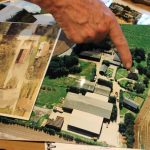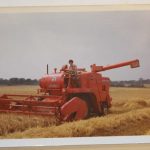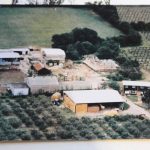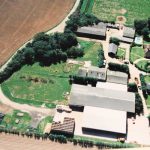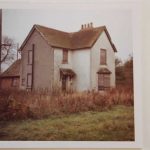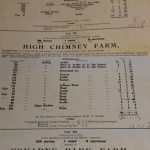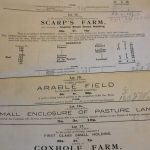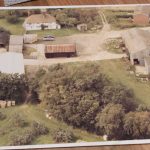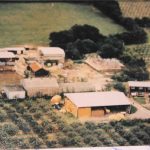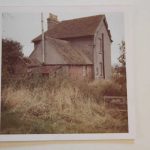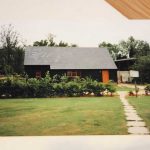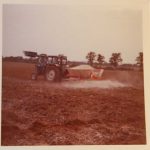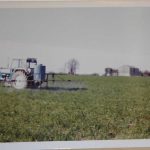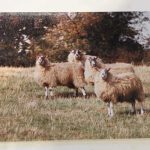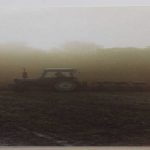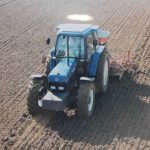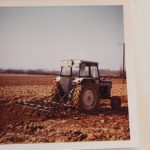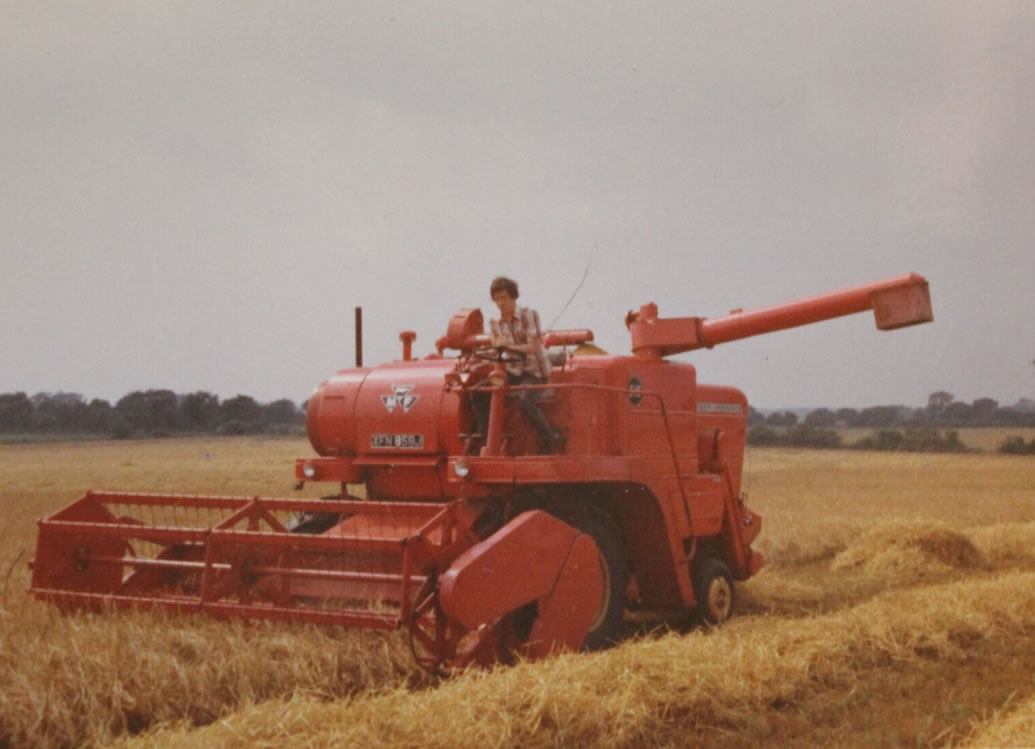
John Haffenden
About
| Farmer’s name | John Haffenden |
| Age | mid 60s |
| Location | High Chimney Farm, Tenterden |
| Size | 750 acres |
| Type | Arable |
Interviewed by: Louise Rasmussen
Date: 9 July 2015
Transcript
(Looking through photographs and maps of the farm)
John: That is the farm when we bought it, and that was in the 1960s.
…
J: So this is the original farm we bought, and then you can see that the next thing is that some of the hedges came out and the fields got bigger, and so you keep going to…and then we acquired these bits of land here, and so it’s a …and then we got another piece of land down there and the fields keep getting bigger.
…
J: This was 1976, when we bought this farm where we are on now.
…
J: So again you can see lots of small fields, all fruit and then they became bigger fields. And then acquisition of more ground there.
Louise: So how big was it back when you acquired it?
J: That was 75 acres. So it’s grown 10 times in this period, and then we ended up with land there, and then this is the current situation.
L: And now how big is it?
J: 750.
L: 750 acres.
J: So 300 hectares or so. So that gives you a flavour of how things have developed. And what started off here is a field that was miles away from the farm, those two fields, suddenly they’re joined in with the rest.
L: And what sort of farm is it now?
J: Mainly arable. So it’s, wheat, rape, beans, potatoes, and then we have some, we now farm our neighbour’s land, which is not on there. That is all grass, so we have beef cattle on that.
L: And how has it happened gradually, that the farm has become bigger?
J: Because in the…when we bought the farm, it was possible to buy little areas of land as they came up. As you can see most of the acquisitions are small parcels of land: 4, 6, 10 hectares at the time. And so you could afford to buy them at a reasonable price, and then they’ve all pieced together. You could never do it now, it would be impossible.
L: Did they used to belong to other farms, those fields?
J: Yes. There are several. We bought several farms that already were…this farm here was three farms, but when we bought it, we bought it as one parcel, but historically it was 3 farms. And you know, so probably there’s 5 or 6 farms that we farm now as one.
J: This is a project I did at school in 1971 on the farm … Most of the pictures I’ve used again. … Explaining how to plough…and buildings… I think all the photographs are in there now. Drawings of the machinery…
…
J: But I’ve got the deeds from the estate here. When all these parcels of land were all part of a big estate, and this is in 1919. So hundred years ago, and the land is for sale. This is the sale particulars of the farm here in 1976, and this is the brochure of the farm, that’s the extent of the farm as it was. The original farm that we got, which is the first page of this, was sold in 1962, 71 acres, 2 rods and 31 perches. And then 6 acres of pasture next door. So that’s the sale particulars.
L: Was the farm then, back then from the first page, was it bought by your family or?
J: Yes, bought by my father.
L: And then you’ve taken over since?
J: Yes. But my father was, he had a, he wasn’t a farmer. So he bought it, bought the original parcel as an investment. And only then did it become clear that I wanted to go farming. … So this is the estate in 1919, which totalled 1000 acres. And the… all the different farms were noted in it. And we have somewhere… Coxhole farm is part of this farm now. We have some of the land from that. And the Scarp’s farm is the one I just showed you the particulars of. And that got…and sold, that was 30 acres was sold for £950. High Chimney farm, that we’re here, 92 acres … that was sold for 1200 pounds including all the houses and everything.
L: So there were other farms in Stelling Minnis…?
J: Yes, the whole of the estate here was the Stone Street and Friar Park Estates. So it was a big area here. And I have all the purchase prices, so the first piece of land that we bought was … where’s Scarp’s here… 1966. And that was 50 acres, and that was 1800 pounds, and then we bought the 100 acres in 1970, so 45 years ago, was the first parcel that you’ve got on there, 1600 pounds… Small field, 10 acres for £7600. The whole of this farm here that had 3, 4 dwellings and all the buildings, and a 180 acres, and that was £120,000. So it’s all the purchase prices. I dread to think what it would cost now.
…
J: (looking at a picture) My wife, when we first grew potatoes in 1989. She was expecting our daughter at the time. And that’s the original farm.
L: This farm?
J: No, it’s the first one on this page there, that’s the first 75 acres we bought. And the house was derelict. … Yeah, this is the farmhouse when we bought the farm, and then we’ve…we renovated. So the white is this piece, and then we built the extension on and you can just see that all finished here.
L: Where is that on this map now?
J: This is the farm right here, you can just see the house. So that was our original purchase. But as you can see, the buildings were very dilapidated. So we then rebuilt the house, and that was the original farm, and most of these buildings were there, but we’ve extended this roof and put that building up and these silos, when we… after 2 or 3 years.
L: Do you know how old the buildings were when you bought it?
J: Before that? ppfff…They would have been in the, I would have said at least 50 or 60 years old, if not more. But they were all boarded up, uninhabited. … And that’s a picture of the farm here, when we bought that, that’s this house and the farmyard that’s changed quite a lot. There’s a picture when we were rebuilding the house.
L: Is that this house?
J: Yes.
L: So you tore it down and rebuilt it completely?
J: Yeah, I’ve got hundreds of photographs of that. … So this is what it looks like now, more or less. It’s been extended more, but, you can see there were hardly any buildings at all. The only buildings were these two buildings here. This one had been knocked down and rebuilt. …
L: And today what are these buildings?
J: These are potato, cold store for potatoes, potato-graving shed, and they’ve been extended again since. But that’s about 1992, something like that.
Joe: Have you still got them?
…
J: So that’s when we rebuilt the office, which was just over there, which was this building.
…
J: And some of the old machines, old sprayer with wooden booms… That’s about 1990, no 1983, I think, that one. And this is when we first did potatoes, we had our own trailer.
…
J: That’s the farmyard, and the original farm, this one. That’s when this farm was sold in 1949; so it was sold in 1919 and then again in 1949. This is Phaseolus beans, for baked beans, old tractor with a canvas cab.
L: When are those taken?
J: Probably 1970. … Ploughing, that was again about the same sort of period, that was probably about ’75. This is the cattle yard here with the cattle in it.
L: Do you still have cattle now?
J: Yes. They’re all here now, on this farm. … This is lifting potatoes. …
L: So when your father bought the farm initially, was there no farming? Or he didn’t use it for farming?
J: Well, we did, we used it for farming, but he was not a farmer. So he had a manager who looked after it.
L: And then when did you start taking over?
J: I started in 1978, that’s when I came farming. (looking through pictures)…Planting potatoes…cattle…wheat diseases…spraying again…combine, how a combine works. Throwing small bales into the barn – don’t do that anymore…
L: How did you find out that you wanted to get into farming?
J: I had always shown an interest, and … (looking through pictures)… That’s planting potatoes in 1989, a more modern sprayer, not modern anymore. … Converting our sheep building into a potato store.
L: When you expanded the farm, did you expand the crops as well, so you had more varieties?
J: Well, we started growing potatoes, which we grew for seed. We started that in 1989. And…so we’re always looking for opportunities to exploit…(looking through pictures)… ploughing, planting…
L: And when did you start getting cattle as well?
J: We’ve had cattle ever since we started. But we used to buy them in as calves and then fatten them. But now we run cows and they rear their own calves.
…
L: And have you expanded into different types of arable as well?
J: Well, we grow things like oilseed rape now, that we never did 40 years ago. I think one of the biggest changes, which is shown on those maps, is how the fields got bigger, and that allowed you to have bigger machinery.
… (looking through photographs)
L: What happened to the older machines?
J: They get sold. I try not to hold onto machinery that we don’t use anymore. … (looking through pictures). That’s a new grain store, that’s now an old grain store. … And here, we use contractors more now for specialist jobs, we used to do all the baling ourselves and moving the bales. Now we just get somebody in with a specialist equipment, and they come in, do it and go away again.
L: Is it because you have a higher workload now?
J: I think yes, probably. Everything has to be done much more quickly now, you know. We have to get over a lot more…we have 10 times more land and we still have to get it done all at the same time, and yet we’re employing less people.
L: So how many people are working on the farm?
J: One. Well, my wife and I, and then one worker who you met out there. … (looking at picture) That’s when it used to be a fruit farm.
L: So when is that from?
J: That was taken about 1990, when we got rid of nearly all of the fruit. The whole of this farm was fruit. Either apples or soft fruit. It had strawberries, blackcurrants, blackberries, all grown for the fresh market. And we bought the farm very cheaply and thought, well, we’ll be able to make that work, but it was very quickly apparent that we…that the fruit was not gonna pay, so we took it all out.
L: Is it more work to keep fruit as well?
J: Fruit…a lot of crops become more specialist. … (looking through pictures) spreading chalk…
L: What do you use chalk for?
J: To get the pH correct in the soil… We had sheep on the farm, which we don’t anymore, and a sheep dog.
L: How come you don’t have sheep anymore?
J: We started growing potatoes, and so we use the shed that they used to lamb in, to store potatoes.
L: And how come you opted for potatoes?
J: We had a meeting with somebody who wanted, who knew how he wanted seed potatoes grown and he had to have clean soil that had not grown potatoes for a long time. And…the original idea was that we would maybe export them through the tunnel. So we were close to the tunnel, we had clean ground, and so we embarked on growing seed potatoes, which we still do. But most of them go up into East Anglia, very few go abroad.
…
L: So your potatoes are going to France…?
J: No, they go to East Anglia, Norfolk, Suffolk, Essex, that sort of area, Lincolnshire. Some go into Wales, some down into…a few into Kent, some into Hampshire and then we go to the Isle of White, and the Canary Islands. Some seed goes down there. But very little goes into France. They grow very different varieties over there. So…it’s different. So… we still grow seed potatoes, and that’s a stand alone business that’s based here, so we have other partners involved in that. And so on this farm here, we have the farm business that is combinable crops; wheat, barley, rape, beans, and the grass for the cattle, and then separate to that we have the potato business. And if we grow potatoes on this farm, the potato business pays us a rent for the land. So we take the potatoes around the local area within a 5 or 8 mile radius of here. And so we can keep having clean soil. We try and have a 10 year gap between potatoes.
L: Now, looking at all these things, what do you think have been some of the major changes of the past 50 years?
J: Well, I think we’ve got field sizes is one thing. But admittedly, this farm was in orchards, so you had very small fields with windbreaks to protect the fruit. So when the fruit went, the windbreaks went as well, so the fields got a bit bigger. I mean the fields here are still small in comparison to the national average, but they’re still – as you can see – they’re much bigger than they were initially. And…tractors and the amount of labour involved has gone down because we’ve become more mechanised. So we don’t do small bails anymore, so we just get big bails done, which we can move with a forklift rather than doing it by hand. So there’s much more mechanization, and the machines are much more sophisticated now, they do a much better job, quicker, much better working environment. So I think the mechanization and field sizes are the two biggest differences. The other thing is the relative cost of land has gone up enormously, so it’s not possible now to buy a field from a neighbour. Because if the neighbour has a field, he’ll probably get sold for horses.
(The cat is jumping around on the photos…)
J: So there’s no opportunity now to do what we’ve done over the last 40 years of buying little bits of land and making a jigsaw of, to get a bigger farm. So it’s much more difficult to start farming now than it was. The price of wheat in real terms has gone down all the time, so …yeah, we were selling wheat probably 25 years ago at a 100 pounds a ton, and it’s a 100 pounds a ton now, and yet all our costs have gone up. So we have to be more productive to be able to make the, still keep the farm profitable. So our yields have gone up a lot. Our costs have gone up, so we’re forever having to run faster, to stay in the same place. We have new genetics that makes the wheat yield more every year. ’Course we’re not allowed to use genetically modified crops, which in my opinion is crazy. You know, we can import genetically modified crops from other parts of the world but we’re not allowed to grow them ourselves. And it’s a pity because I think we could reduce our chemical reliance if we had crops that were tolerant at certain herbicides, it would, I think it would be a benefit. And at the moment it’s just not, it’s not gonna happen because we have too much food around. When food starts to get short then people will not worry about genetics anymore, they’ll say well if we can get more food let’s have it. But now in a time of surplus they’re not interested, so we have to accept that. So yes, I don’t know…Yeah, I think farming just evolves all the time, and whatever the signals are from our market, be it a political signal, or whether it’s an economic signal then we respond to it. And in the 1960s the government were giving grants for taking hedges out, now they’re giving grants for planting hedges, so in the 1960s we all took hedges out, now we’re planting hedges. So we respond to whatever signals are given to us politically or economically. And again, oilseed rape has lost favour slightly now because the price has come down, it’s not an economic crop to grow. And so people look for something else. And under the current rules of the basic payment scheme, we have to grow pulses, so people have grown beans to satisfy the requirements of the basic payment scheme. There’s a signal there and we respond to it, so we’re having to respond all the time. So that’s what we’ve done ever since we’ve been farming, and all the while that we keep responding and changing what we do then we’ll survive, but you can’t stand still.
L: Do you feel that the signals that you sort of get, that they’ve changed over time? Because I have the impression that there may be more of those signals nowadays than there maybe used to be?
J: I don’t know, I don’t necessarily think that’s true. I mean the signals are coming out of Europe rather than out of Westminster. Sometimes Westminster make more of a rule than is necessary, so Brussels will issue an instruction. One example is that they said that all the metal in a slaughterhouse has to be non-corrosive. And so in France they use galvanised iron, our government decided that that meant it had to be stainless steel. Stainless steel is twice the price of galvanized, they’re both non-corrosive. So the French have complied with the rule, we’ve complied with the rule, but we’ve done it in a very expensive manner. So I think there’s always been signals, we used to have payments from the government for wheat ever since I can remember. It’s just the form it takes is different. We certainly have much more in the way of legislation and guidance on pollution and the environment now than we ever did in the past. And the agrochemicals are becoming much more specific in what they do. So you can now spray a crop and kill the aphids but leave the ladybirds alive, whereas probably 40 years ago you’d kill every worm, insect, pest, fly, everything. It would be much less specific so the chemistry is much more sophisticated now, but the controls we have are much more rigorous as well. So they control what we can do and the environment is much more important now to the politicians than it’s ever been before. But we have the luxury of having too much food. All the while we have a surplus of food, we can afford to make all the stipulations about everything. But I think that will change if ever we got to the situation where food became short. I’ve just been to a meeting and they said in 1970 one farmer fed 19 people. And in the 1990s, I think that went up to 78 people, and now it’s a 198 for one person. Excuse me…
(Gets up and goes out to talk to somebody…)
(Mr. Haffenden comes back, asks me which pictures and maps I would like to have a photocopy of.)
L: You showed me a machine with wooden parts, I just don’t…
J: With the booms?
L: Yeah.
J: Wooden booms, yeah.
(looking for the picture…)
…
L: Do you still have pigs today?
J: No, we only had, that was only a pet.
L: Are these machines still in use today?
J: That’s planting corn, cultivating and putting the seeds in, and this one is ploughing and then pressing…You have these rings that press the, plough the ground down ready for this machine, so that one follows the other.
…
L: It’s really interesting to see the maps of the farm as well, how it’s become bigger over the years.
Mrs Haffenden: Yes, well, I mean, you can’t…because less people work on the land you have to have more machinery and you have to have bigger fields. You can’t, I have a farm in Devon where the field boundaries are the same since they’ve been since 1910, which is all very interesting, but it’s not a farm that is easy to look after because the fields are too small. And it’s alright, I mean it’s livestock, but you have miles of extra hedges to cut and it’s a nice idea and…but it’s the practicalities. There aren’t people about to lay hedges, to mend the hedges in a traditional way, you need machine…you know, everything is done by machine. And it’s just, you know, gateways are too small and…it’s just, it’s not an easy option…
(Mr. Haffenden comes back with the photocopies.)(Looking through the deeds of the estate…)
L: You bought… you said you bought some of these farms as well?
J: Yeah, we had… High Chimney Farm, and there was another one… Scarps Farm, that was the original one that we bought.
…
L: Was that the price back then?
J: Yeah. Looks like 1800 pounds. All of High Chimney was bought for 1800 pounds …
(Talking about the different years in which the pictures were taken…)
L: The fruit farms on the map…?
J: Yeah, that was 1990, that was the last orchard. And it’s one that we planted, the only orchard we planted here, and it was the last one to go.
L: And where was that on the map?
J: The field behind the house, here.
L: And when did you stop having sheep?
J: 1989, I got rid of those. And that’s the first year we grew potatoes.
…
J: So that would have been taken in 1976, the picture of the farm, aerial picture.
…
L: When you look back at these things now, what do you think about the changes, or how do you feel about all the changes?
J: I’m surprised how much we’ve done. I mean, you wouldn’t recognize it from, I mean all the hedges, all the trees here I planted. And all the hedges and everything, and this was storage for apple boxes to within 5 meters of the house. Just stone here…so now the grass goes all the way to this building, and there’s a hedge all the way along here, all the trees in the yard I planted, it’s very different. … (pointing to the picture) So this is orchards, very old orchards, which is now this field here, that’s filled with peas. So actually the aspect is that more or less, so that is the house (picture with Mr. Haffenden’s finger on it), so the house is there and that’s the house, and the house has changed a lot too, and those, there are two cottages, which are here, and these buildings are those two buildings. So all these buildings are new, and these have been extended now.
L: And this was where…is the potato storage now a cold storage? And the sheep used to be in there?
J: The sheep used to be in this building, with straw, which you can see from another one of the aerial, the older aerial photos.
L: How many people did you use to employ in the past, compared to now?
J: I think, I don’t think we’ve ever employed more than 3 people.
…
J: (Looking at another picture) That’s a very old one…
L: What type of machine is it?
J: That’s planting, that’s planting wheat. So we’ve got 3 very old tractors cultivating and planting wheat. That was before this picture, which was 1970. I think this is 1966. … And that’s a piece of land that we had right over on the coast at Sandwich.
…
J: I’m trying to find a picture of the house being built, because that shows the barn with the straw in it for …
…
J: There we are. So this is the barn when we had it for sheep. And it was just 4 bays long, that’s 10 bays long now, and it comes out to here. And it was full of straw and then the sheep were at the other end, and this is when we were rebuilding the house, and that was in 1982 that one. So this is now 2 bays longer again, so it was 10 bays long, and then this is another 4 bays long and one bay on the end, so it’s now a square building. So that started, that was that little bit of the grey building, that one. And you can see all the fruit trees here, and fruit there and fruit here.
Audio
Photos and Documents
John Haffenden Interview Archive – Download .pdf version
